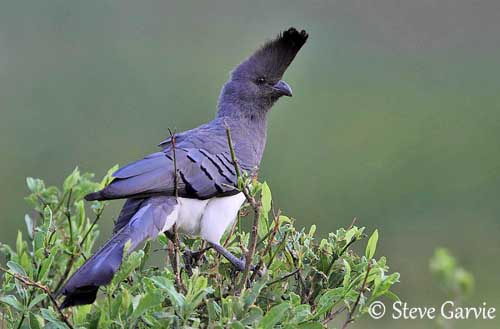
Fr: Touraco à ventre blanc
All: Weißbauch-Lärmvogel
Esp: Turaco Ventriblanco
Ital: Turaco ventrebianco
Nd: Witbuiktoerako
Sd: Vitbukad turako
Photographers:
Jean Michel Fenerole
Photos d’Oiseaux du monde
Steve Garvie
RAINBIRDER Photo galleries
Text by Nicole Bouglouan
Sources:
HANDBOOK OF THE BIRDS OF THE WORLD vol 4 by Josep del Hoyo-Andrew Elliott-Jordi Sargatal - Lynx Edicions - ISBN: 8487334229
BIRDS OF AFRICA SOUTH OF THE SAHARA by Ian Sinclair and Peter Ryan - Princeton University Press Princeton and Oxford - ISBN: 0691118159
L’ENCYCLOPEDIE MONDIALE DES OISEAUX - Dr Christopher M. Perrins - BORDAS - ISBN: 2040185607
BirdLife International (BirdLife International)
White-bellied Go-away-bird
Corythaixoides leucogaster
Musophagiforme Order – Musophagidae Family
BIOMETRICS:
Length:
50 cm (tail = 24 cm)
Weight: M: 170-225 g – F: 225-250 g
DESCRIPTION:
The White-bellied Go-away-bird is a fruit-eater. Its name comes from its calls described like “go-wayeer”.
Both sexes are similar.
The adult has grey upperparts with dark grey to blackish pointed crest of about six centimetres long. On the upperwing, the black tips of median and greater wing-coverts form black bars on closed wings. The black primary’s white bases form a white patch visible in flight. The tail is black with a broad, white median bar, and this pattern is similar below.
On the underparts, chin, throat, neck and breast are grey, similar to upperparts. Belly and undertail-coverts are white, giving the bird the first part of its name.
On the grey head, the long, pointed crest of about six centimetres is grey, with darker brownish-black tips.
The bill is black, greenish in female (becoming yellowish during the breeding season). The eyes are dark brown. Legs and feet are black.

The juvenile is similar to adults with browner plumage, especially on wing-coverts.
VOICE: SOUNDS BY XENO-CANTO
The White-bellied Go-away-bird utters varied calls, among them the usual loud, nasal “haa haa haa” or “gwaa”. These calls are repeated several times, and often given as series by two birds engaged in duets.
Other calls are almost saying “go-wayeer”, giving the species its name.
HABITAT:
The White-bellied Go-away-bird frequents hot acacia steppe and savanna, and also wooded areas. It prefers to remain within the deep forest, but the species is visible from sea-level up to 1700/2000 metres of elevation.
RANGE:
The White-bellied Go-away-bird is restricted to its preferred habitats, the acacia savannas in E and NE Africa. It is found in Somalia, W Ethiopia, S Sudan, NE Uganda, N and E Kenya and southwards, in the eastern plateau of Tanzania.
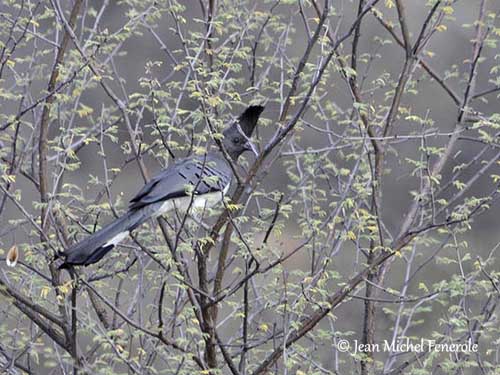
BEHAVIOUR:
The White-bellied Go-away-bird feeds primarily on plant matter such as fruits, flowers and nectar, seeds and buds of acacias and other plant species. It also favours the green pods of Acacia tortilis. It may probe nectar from flowers and takes some invertebrates such as winged termites.
It is very agile when climbing in trees. It may run over large branches too. However, it regularly descends to the ground for drinking and sometimes for bathing as part of plumage maintenance.
This species can be seen alone, in pairs or in small family groups.
The White-bellied Go-away-bird is considered a pest in some regions, raiding orchards and plantations of fruiting trees and vegetables too.
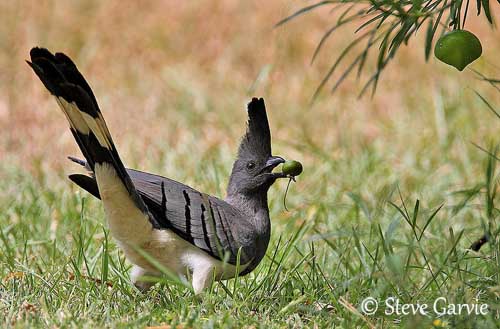
They are territorial and remain for long time in family groups. As sedentary species, the territorial pair probably maintains its territory all year round, from which all intruders are chased away.
During the breeding season which usually starts with the rainy season, they become much more vocal. Chases from tree to tree are performed, and also mutual feeding. During these displays, the crest is alternately lowered and raised. The birds bow and flick the long tail. The black and white pattern is enhanced by these postures.
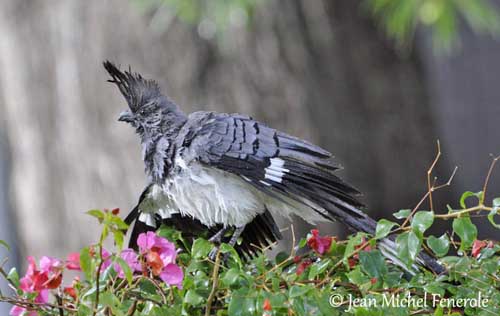
The White-bellied Go-away-bird is sedentary in its range. It may wander locally when searching for water and food sources.
FLIGHT:
The White-bellied Go-away-bird performs weak and laboured flight, and usually, it flies mainly short distances and moves noisily from tree to tree.
REPRODUCTION:
The breeding season varies according to the range, from February/July in Somalia and Ethiopia, February/August in Kenya and Tanzania, to July/August in NE Uganda.
The White-bellied Go-away-bird is monogamous. The nest is placed in acacia-type tree, between 3 and 12 metres above the ground. This is a flat and flimsy structure made with twigs, often similar to those of Columbidae species.
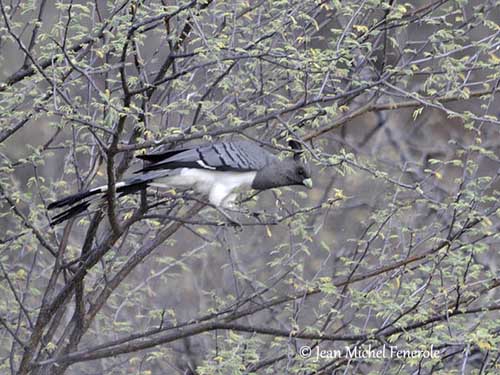
The female lays 2-3 pale bluish eggs. Both sexes incubate during 27-28 days. The chicks are fed by regurgitation. After 2-3 weeks, they clamber about in the nearby branches. The first flight may occur 4-5 weeks after hatching. However, they still depend on parents for food for several weeks after fledging.
DIET:
The White-bellied Go-away-bird feeds mainly on plant matter such as fruits, leaves, flowers and nectar, seeds, acacia buds and green curved pods of Acacia tortilis. Some small invertebrates are taken too.
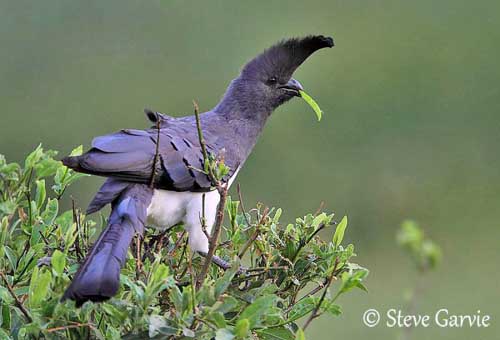
PROTECTION / THREATS / STATUS:
The White-bellied Go-away-bird is common throughout the range. Predation by birds of prey, monkeys and snakes occur, but populations appear relatively stable.
This species is not currently threatened.
